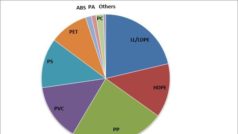The ERF 500 model will be added to the ERF melt filter series, already proven in numerous installations for filtering heavily contaminated feedstock, and the ECO, specially developed for complex extrusion processes in the manufacture of films, sheets, and other semifinished products.
The ERF 500, which according to Ettlinger is designed for a maximum throughput of 5000 Kg/hour, will be launched as a standard product to coincide with Fakuma, rounding off Ettlinger’s established series of high end filters for recycling post-consumer and post-industrial plastic waste. The ERF 200 and ERF 250 sizes available so far achieve a maximum respective throughput of 1.5 ton/hour and 2.5 tons/hour. The new ERF 500 shares the same compact design and; like all of the other ERF filters is extremely durable, able to handle contamination amounts of up to 18% by weight. The consistently high filtration efficiency assures a combination of high product quality and minimal melt loss. The ECO melt filter – which will also make its debut at the upcoming Fakuma – was specifically developed for film and sheet extrusion applications. The ability to effectively remove the cross-linked and high-molecular material fractions contained in the melt together with any gels or partial impurities is often crucial – and at the same time the filter must be built to last. This melt filter, rated for a maximum contaminant level of 1.5% by weight, is offered in two different sizes: as the ECO 200 for throughputs up to 1000 kg/h and as the ECO 250 for a maximum of 2500 kg/h. In addition to polyolefin melts, it is also suitable for filtering easy-flowing materials such as PET or PA. With their compact, space saving design ECO and ERF melt filters can be retrofitted in existing extrusion lines without any problems.
The central component of both the Ettlinger ERF melt filter and the ECO filter is a rotating, cylindrical filter screen with millions of conical holes that can be supplied with a wide variety of filtration levels. When melt flows through the filter, contaminants are retained on the outside of the screen – in addition to solid contaminants like wood and aluminum particles or paper, the high-molecular and cross-linked fractions which arise due to high temperature stresses are efficiently removed from the melt along with gels. The cleaned melt on the inside of the drum is supplied to the downstream mold via a system of flow channels. The rotary motion of the filter drum simultaneously supports the blending effect and ensures optimally homogeneous conditions in the melt.
With every revolution the slowly rotating filter screen, which is driven by a servo motor, is cleaned by a scraper. The particles that are removed from the surface of the screen are continuously fed either to an exit screw (ERF filter) or to an innovative discharge shaft (ECO filter), each driven by a second servo motor, which discharges the contaminants from the filter system. In automatic mode the melt losses due to the continuously discharged contaminants are only minimal because these contaminants are highly enriched (up to 70%) at the exit.
Since the screen of the ERF and ECO filters remains open throughout the production phase, reliable and stable processing is guaranteed; the melt pressure downstream of the filter remains constant, as does the melt throughput. Thanks to this unique combination of exceptionally durable filter medium and continuous, trouble-free production, the investment in the ERF or ECO filter pays for itself very quickly.






